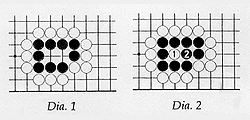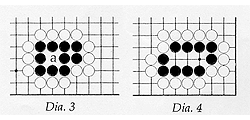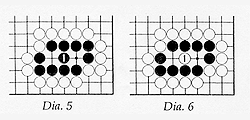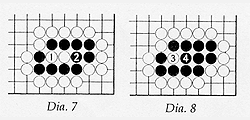International tournaments
With the emergence of Chinese and Korean go players who were clearly as strong as the top Japanese title holders, it became clear that a venue was needed in which all the top players in the world could compete against each other to determine who was the world's strongest player.The first professional international tournament was the Fujitsu Cup, first held in 1988 and dubbed the World Go Championship. In this tournament top players from all over the world vie for a 20,000,000 yen first prize.
The following year, the Ing Cup was established by Ing Chang-ki, a Taiwanese industrialist. This event was held only once every four years, but the winner's prize was 400,000, dollars so it attracted a lot of interest.
In 1990, the Tong Yang Securities Cup was transformed from being a solely Korean affair to an international tournament with a winner's prize of 120,000,000 won (about 91,000 dollars at today's exchange rate).
In 1996, two tournaments were founded by Korean companies. The first was the LG Cup, offering a first prize of 200,000,000 won (about 152,000 dollars).
Quickly following on the heels of this tournament came the Samsung Cup, which offers a 400,000,000 won (about 304,000 dollars) first prize. This last tournament is unique in that it is an open tournament in which anyone can compete to join the seeded players in the main tournament. However, all competitors in the preliminaries must pay their own expenses, something previously unheard of in a professional tournament. For every win in the preliminaries, there is some prize money, about 1,000. dollars
The big lure, however, is the 400,000 dollars prize for the winner.
There is also a world championship tournament for women called the Bohai Cup. Since its inauguration in 1995, it has been dominated by Rui Naiwei, who is indisputedly the world's strongest woman go player.
She has won this tournament three times, while her main rival, Feng Yun, has won it once. Both Rui and Feng are Chinese, but Rui now lives in the United States, where she teaches go and competes in various international tournaments. Her go strength is on the same level as the top male professionals.
There is also an international TV tournament in which the finalists from the TV tournaments in China, Korean and Japan play a knockout tournament for the TV Asia Cup. The games of this tournament are broadcast live in the participants' countries. Each player must make a move within 30 seconds, but has 10 minutes free-thinking time.
Eye spaces
  |
In Diagram 4, the black group surrounds a three-point eye space.
 The life or death of this group depends on whose move it is. If Black plays first, he lives by playing 1 in Diagram 5. If White plays first, he kills Black by placing a stone at 1 in the middle of this eye space in Diagram 6.
The life or death of this group depends on whose move it is. If Black plays first, he lives by playing 1 in Diagram 5. If White plays first, he kills Black by placing a stone at 1 in the middle of this eye space in Diagram 6.
If White is called upon to show that it is dead, he ataris with 1 in Diagram 7. If Black captures with 2, the position results in the two-point eye space similar to Diagram 1. White ataris with 3 in Diagram 8 and, after Black captures with 4, his only liberty is his one real eye at 3. White can capture this group by playing on this point.

